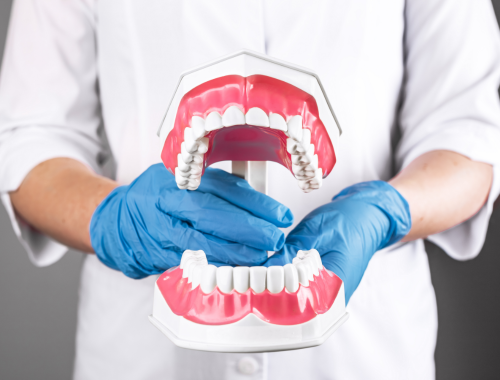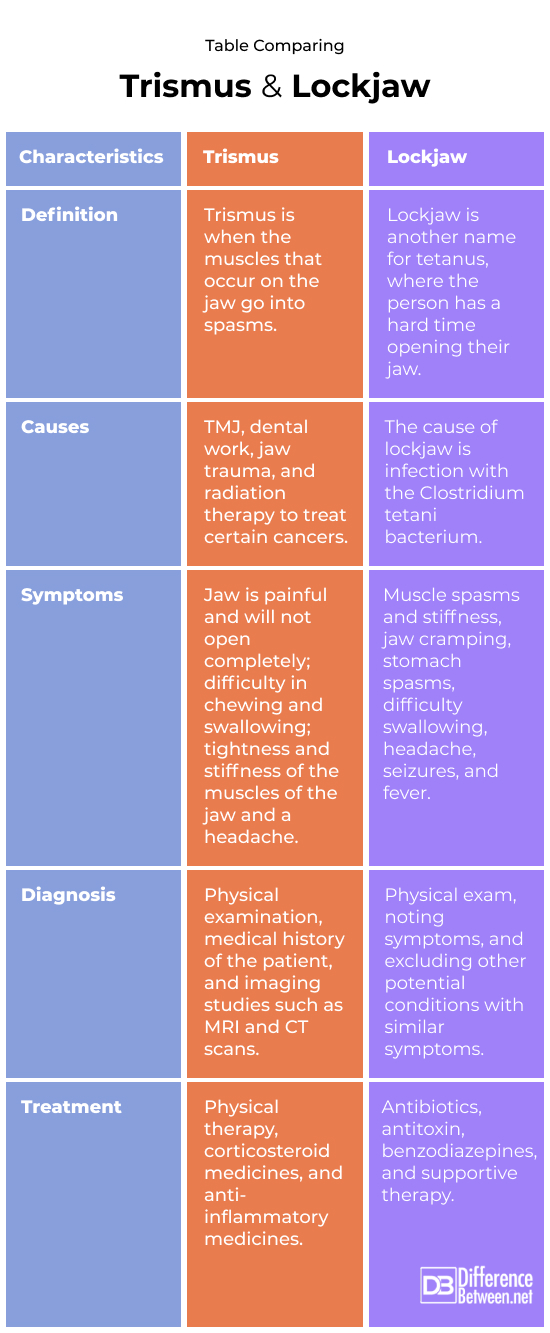Difference Between Trismus and Lockjaw
Trismus is when the TMJ joint is in a spasm causing jaw problems. Lockjaw is another term to describe tetanus, which also impacts the jaw.

What is Trismus?
Definition:
Trismus is the condition where the muscles of the temporomandibular joint go into spasm.
Causes and prevalence:
There are a couple of reasons why a person may develop trismus. The conditions that can cause trismus include TMJ, trauma to the jaw, dental work, and radiation therapy. It is the radiation therapy that targets the jaw area while treating neck or throat cancers, which can cause trismus as a side effect. The prevalence of trismus varies from about 5% to 38% depending on the cause of the problem. It tends to be quite common in patients with cancer of the neck and throat region.
Symptoms:
Signs you have trismus include pain when trying to open your mouth, difficulty in opening your mouth, not being able to open your mouth completely, and having a hard time chewing and swallowing. You also may find that the jaw muscles feel very stiff and tight. Some people also experience a headache along with the other symptoms mentioned here.
Diagnosis:
Diagnosis is by a physical examination and medical history. The doctor may measure the width of your jaw opening and send you for imaging studies. Imaging tests like MRI and CT scans can help give detailed information on your jaw and the surrounding muscles.
Treatment:
Treatment options including physical therapy where the jaw muscles are massaged. Other options include using corticosteroid and anti-inflammatory medications.

What is Lockjaw?
Definition:
Lockjaw is a term frequently used by medical professionals to describe the condition of tetanus.
Causes and prevalence:
Tetanus is caused by infection with the bacterium Clostridium tetani. The bacteria enter the body through cuts or punctures, or through trauma to the skin such as can happen with a burn injury. Tetanus is less common today than in the past because of vaccination against the bacterium. The Tdap vaccine is part of the routine vaccination schedule for children and is the reason that cases of tetanus are greatly reduced.
Symptoms:
The signs of lockjaw are due to a toxin that the bacteria produce. These symptoms of lockjaw include: stomach spasms, stiff muscles, cramp in the jaw, difficulty swallowing, sore throat, headache, fever, arching of the back, and seizures.
Diagnosis:
Diagnosis is based on the symptoms, a physical exam, and a history of skin injury. Other possible conditions, such as meningoencephalitis, may need to be excluded through further testing as symptoms can be similar.
Treatment:
Treatment is largely by supportive care and by antibiotic therapy, and using tetanus antitoxin. The antibiotic that is most commonly used to treat tetanus is Metronidazole. Certain benzodiazepines can be used to help relax muscles that are in spasm due to the condition.
Difference between Trismus and Lockjaw?
Definition
Trismus is when the muscles that occur on the jaw go into spasms. Lockjaw is another name for tetanus, where the person has a hard time opening their jaw.
Causes
The causes of trismus include the following: TMJ, dental work, jaw trauma, and radiation therapy to treat certain cancers. The cause of lockjaw (tetanus) is Clostridium tetani infection.
Symptoms
The symptoms of trismus are a sore jaw that will not open completely; difficulty in chewing and swallowing; tightness and stiffness of the muscles of the jaw and a headache. The symptoms of lockjaw are muscle spasms and stiffness, jaw cramping, stomach spasms, difficulty swallowing, headache, seizures, and fever.
Diagnosis
Trismus diagnosis is based on physical exam and imaging tests. Lockjaw diagnosis is based on physical exam and excluding other conditions.
Treatment
Trismus is treated by physical therapy, corticosteroid medicines, and anti-inflammatory medicines. Lockjaw is treated by supportive therapy, antibiotics, and tetanus antitoxin.
Table comparing Trismus and Lockjaw

Summary of Trismus Vs. Lockjaw
- Trismus and lockjaw both affect the jaw and cause difficulties in swallowing.
- Trismus may be called lockjaw but lockjaw more correctly refers to people who have tetanus.
- Lockjaw (tetanus) is a dangerous condition causing muscle spasms and jaw problems.
FAQ
What is the 3 finger test for trismus?
If you are unable to place three fingers on top of each other in your open mouth, then it means you have trismus.
What is the most common cause of trismus?
The most common reason people develop trismus is TMJ (also known by some as TMD).
What does trismus feel like?
You will likely have a painful jaw and have problems trying to open your mouth fully.
How do you get rid of jaw trismus?
Certain muscle relaxant medications and physical therapy can help with jaw trismus.
How long does trismus jaw last?
The condition usually resolves after about 2 weeks, but in rare cases it can last longer.
Should I go to the doctor for trismus?
It is a good idea to consult a doctor if you have trismus since they can suggest causes of the condition and treatments for the problem.
- Difference Between Rumination and Regurgitation - June 13, 2024
- Difference Between Pyelectasis and Hydronephrosis - June 4, 2024
- Difference Between Cellulitis and Erysipelas - June 1, 2024
Search DifferenceBetween.net :
References :
[0]Bush, Larry M. and M.T. Vazquez-Pertejo. “Tetanus (Lockjaw)”.Merckmanuals. Merck & Co., 2023, https://www.msdmanuals.com/professional/infectious-diseases/anaerobic-bacteria/tetanus
[1]Bush, Larry M. and M.T. Vazquez-Pertejo. “Tetanus (Lockjaw)”.Merckmanuals. Merck & Co., 2023, https://www.msdmanuals.com/professional/infectious-diseases/anaerobic-bacteria/tetanus
[2]Cleveland Clinic. “Trismus”. Cleveland Clinic, 2023, https://my.clevelandclinic.org/health/diseases/24086-trismus#
[3]Dhanrajani, P. J., and O. Jonaidel. "Trismus: aetiology, differential diagnosis and treatment." Dental update 29.2 (2002): 88-94.
[4]Image credit: https://www.canva.com/photos/MADq35hGMCo-f026-5431/
[5]Image credit: https://www.canva.com/photos/MAFWVZZPAQs-dentist-with-open-teeth-jaw-model-in-hand-dentistry-and-stomatology-concept/
